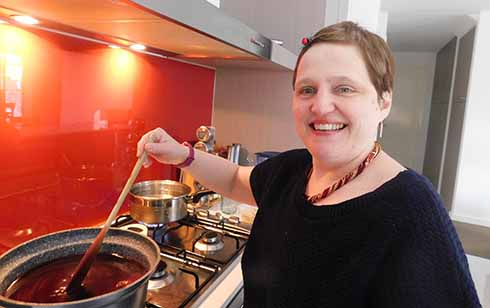 The sharing of food is central to all Catholic celebrations. We gather at the altar to share the Eucharist in joy, just as we gather at each other’s homes to share food and celebrate special events. With Christmas celebrations, Australia’s Polish community have kept traditions from their homeland with a few southern hemisphere tweaks.
The sharing of food is central to all Catholic celebrations. We gather at the altar to share the Eucharist in joy, just as we gather at each other’s homes to share food and celebrate special events. With Christmas celebrations, Australia’s Polish community have kept traditions from their homeland with a few southern hemisphere tweaks.
With Polish ancestry and a Chinese husband, Ewa Ng lives with cultural diversity. However, Christmas tends to be mainly a Polish affair. ‘Christmas Eve is one of those non-negotiable family get-togethers. Everybody has to go home for Christmas’. Ewa says this tradition of stopping and gathering is especially welcome as finding time to be together is difficult as everyone leads such busy lives.
PREPARATION IS KEY
Christmas is also an event that is a long time in preparation. ‘Polish Christmas food is not something that can be whipped up in two seconds. We start cooking about a month before. The preparation is an essential part of Advent, just like lighting the Advent candle and going to Mass.’
As with the food preparation, much time goes into getting the table ready. ‘We start by putting straw on the table first to remind us of the manger and the Holy Family not having a place to stay. This is covered by a white tablecloth and the table is set with the best china.’ There is always at least one candle on the table which is lit at the beginning of the meal.
At every Christmas Eve table there is always an extra place set for the unexpected guest. ‘Christmas Eve is the one night of year where no one should ever be alone. This has its roots in Polish hospitality and is a nice tradition’, Ewa says.
FIRST STAR
In Poland the traditional Christmas Eve dinner begins when the first star comes out. ‘However, in Australia we’d be starving if we had to wait until the first star, so we’ve tinkered it a bit. There’s a star on the top of the Christmas tree so we use that. Of course, the children are always looking for when the actual star comes out because that’s when we can start opening Christmas presents.’
Dinner begins with a prayer, a reading of the story of Joseph and Mary’s travels to Bethlehem and the birth of Christ. This is followed by grace and general thanks. The prayer is led by the head of the house.
Traditionally the meal is pescatarian – fish and vegetables, with no meat or alcohol. ‘We start with oplatek. It looks like communion wafer but is square. It is placed in the middle of the table and everyone breaks off a bit and then goes around to everybody else. We each break off a bit of each other’s and wish Merry Christmas and the best for the coming year. It’s a way of forgiving all the trespasses and reset the family.’
 SOUP FIRST
SOUP FIRST
The first course is soup – traditionally barszcz (borscht) served piping hot with uszka, a kind of vegetarian tortellini (the name means ‘little ears’). Ewa says some people prefer a mushroom soup. ‘After that we have a selection of cold dishes. Pickled herring is traditional. There are vegetable salads, fish in Greek style, which is any firm fish served with Mediterranean vegetables as a salad. In Poland most of the fish tends to be perch and cod but in Australia we’ve adapted. We’ll have prawns and crab salads. Various salads with mayonnaise are served, along with a nice hunk of Polish rye bread.’
After the cold fish and vegetable course there is the hot fish course. ‘We might have beer batter fish, crumbed fish. Because of my husband, we’ll have steamed Chinese fish.’ Her Chinese in-laws often attend the Christmas dinner and she says, other than perhaps different spices, the foods are very similar. ‘When you think about it, Chinese do dumplings, they do pork, they do mushrooms, they do cabbage. It’s never really a huge taste shock other than the spices. We tend to use aromatic spices rather than piquant.’ And once the hot food course is finished then the final savoury dish will be pierogi or paszteciki (Polish sausage rolls). These are crepes with mushroom and cabbage, rolled and baked.
REASON FOR THE SEASON
‘What’s lovely about Polish tradition is that though there is Santa Claus, there is a strong emphasis on the reason for the season. You don’t forget why you’re there, hence why we start with a reading from the Bible and anchor us into the real reason for Christmas. You’ll find in most Polish homes there will be some sort of Nativity scene’, Ewa says.
Finally, the Christmas Eve meal ends with dessert. Usually it’s poppy seed cake (makowiec), found mainly in the East of Poland. Other desserts are kutia (cracked wheat, poppy seeds and honey mixed with minced fruits) or a compote of dried fruit.
 GET READY FOR MASS
GET READY FOR MASS
‘Then it’s presents time. We’ll probably have about an hour or so to chill out, relax, catch up before 11pm when we’ll get ready for Midnight Mass. It’s a very atmospheric Mass for us. You walk into a dark church and start singing a very old Polish hymn ‘God is born’. The lights don’t come on until we say the Gloria. While there are churches that do masses in Polish, there is one strictly Polish church in Melbourne and that is the Marian Shrine in Aberfeldie (Essendon) so many people will go there for the experience of Midnight Mass.’